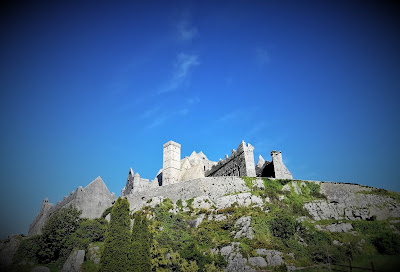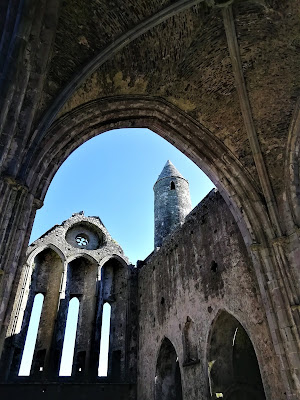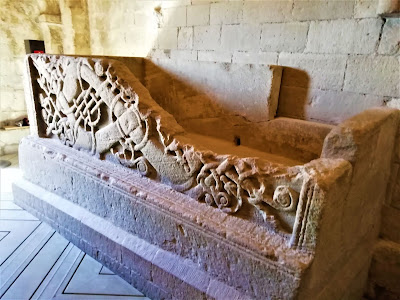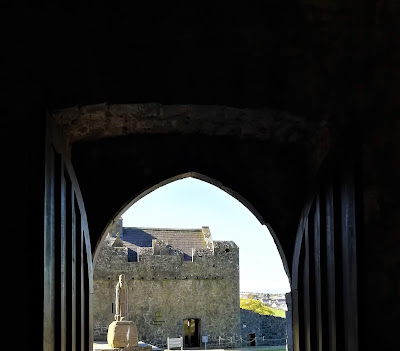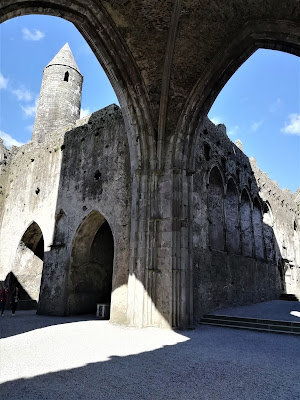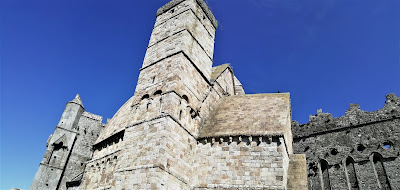The Rock of Cashel in Tipperary is an iconic Heritage Site.
Historically in early antiquity and throughout most of the Iron age Navan Fort at Armagh, The Hill of Tara in Meath, Rathcroghan in Roscommon, and Dún Ailinne in Kildare represented four of the five ancient provinces of Ireland. Respectively Ulster, Mide (Meath), Connaught and Leinster.
Missing from the early archaeological records is the seat of the fifth province, Munster. It is believed that if a prehistoric seat of Kingship existed and governed Munster then it must have been based at what today is The Rock of Cashel.
Today the Rock of Cashel stands as a stunning reminder of powerful ecclesiastical settlement which changed in nature throughout the Centuries.
Originally Cashel was founded as a fortress perched on a rocky prominence which lent itself to easy defense from would be foes or attackers.
From the 5th to the early 12th Century the Rock of Cashel was the domain of the Kings of Munster and subsequently the Dál Cais, a Clare tribe.
The most famous among them Brian Boru, rose to become King of Munster and ultimately High King of Ireland before his victory and death at the Battle of Clontarf in 1014.
It returned to the hands of the McCarthys (Mac Cárthaigh) for a brief period.
The most famous among them Brian Boru, rose to become King of Munster and ultimately High King of Ireland before his victory and death at the Battle of Clontarf in 1014.
It returned to the hands of the McCarthys (Mac Cárthaigh) for a brief period.
In 1101 the Rock of Cashel was handed over to the Church when it became an ecclesiastical seat and remained in use until the middle of the 1700's.
The earliest Cathedral at Cashel was probably constructed shortly after 1101 while construction on Cormac's Chapel (Cormac Mac Cárthaigh, King of Desmond) started in 1127 and it was consecrated in 1134. The Chapel is built in Romanesque style and constructed of Sandstone.
Adorned with ornate carvings both inside and out, Cormac's Chapel is a wonderful piece of architecture. Inside are some partially preserved Frescoes and a barrel vaulted roof.
Also housed within the Chapel is a 12th Century Sandstone Sarcophagus decorated in an exquisite Scandinavian Urnes style (Viking).
The main building on site is the large Gothic Cathedral Church built in the 13th Century and redolent with huge sweeping arch's and ceilings typical of the style at that time. The Tower at the transepts was a later 15th Century addition.
The oldest structure on the Rock of Cashel is the Round Tower and its date of construction is uncertain but thought to be close to 1101. There are 85 complete or partial Round Towers remaining in Ireland, 2 in Scotland, and 1 in the Isle of Man.
Round Towers were constructed from the late 9th to the 12th Century. They served chiefly as Bell Towers and were possibly used for storage and defence from casual looters but a Round Tower couldn't be used to hide from Vikings or rampaging Irish Tribesmen.
A small fire would soon smoke out anyone who took refuge inside and leave them with nowhere to go.
A small fire would soon smoke out anyone who took refuge inside and leave them with nowhere to go.
To the side of the Rock of Cashel is the "Hall of the Vicars Choral". This two storey building was constructed in the 15th Century as a dormitory and housed choristers.
Today it houses a small Interpretive Centre which shows an Audio Visual Presentation, Saint Patrick's Cross, and a selection of relics and antiquities.
Today it houses a small Interpretive Centre which shows an Audio Visual Presentation, Saint Patrick's Cross, and a selection of relics and antiquities.
From the Rock of Cashel you will see the ruins of nearby Hore Abbey (Saint Mary's), a Cistercian Monastery, which is just a short walk from the site. There is also a medieval Dominican Friary nearby in the town of Cashel.
The sheer variety of buildings constructed over so many centuries and
the various antiquities dotted throughout make The Rock of Cashel truly
unique.
For
those feeling more adventurous the impressive and beautiful ruins of
Athassel Priory, Ireland's oldest and possibly largest medieval Priory, are just down the road outside the nearby village of Golden.






